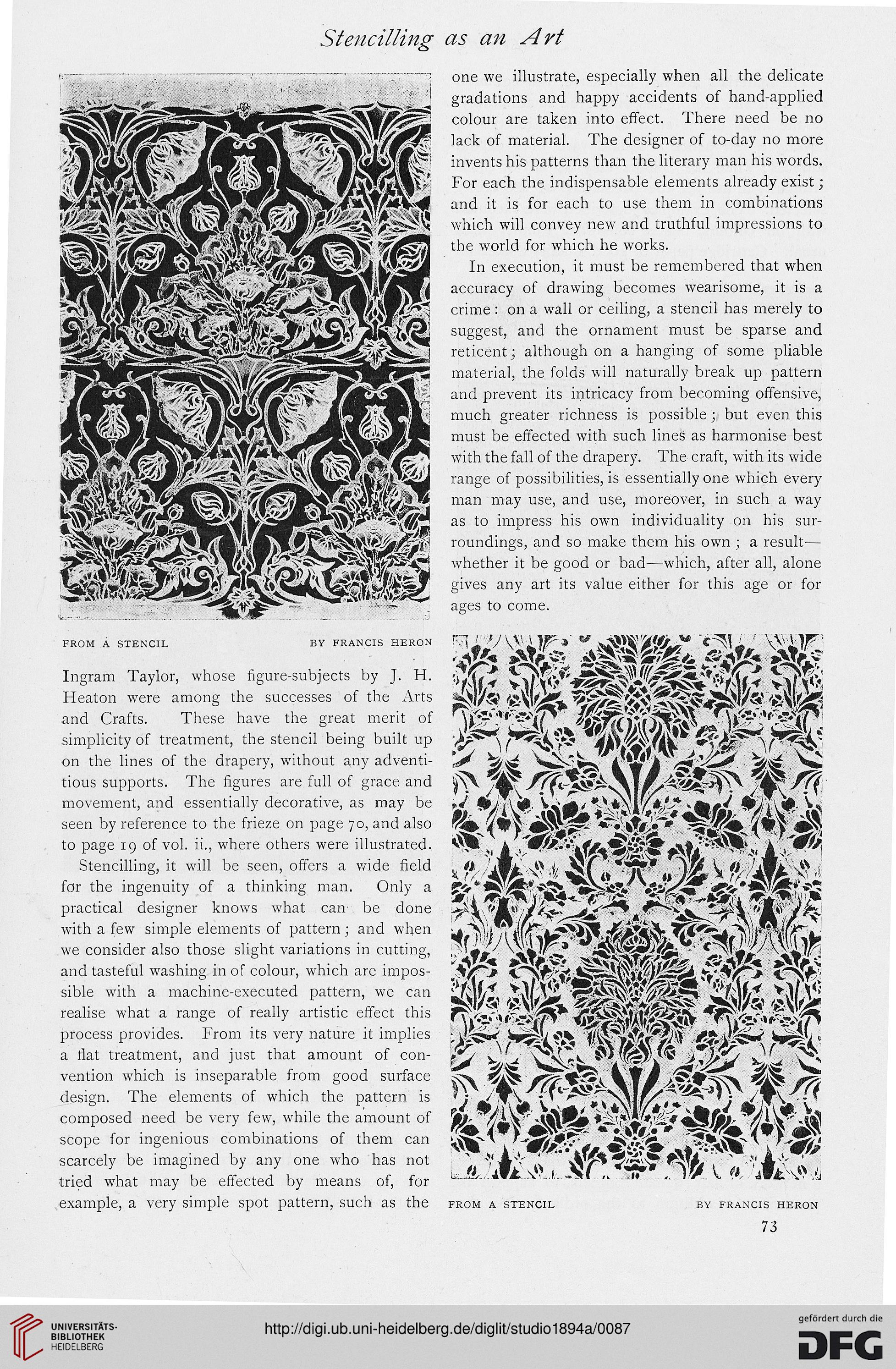Stencilling
FROM A STENCIL BY FRANCIS HERON
Ingram Taylor, whose figure-subjects by J. H.
Heaton were among the successes of the Arts
and Crafts. These have the great merit of
simplicity of treatment, the stencil being built up
on the lines of the drapery, without any adventi-
tious supports. The figures are full of grace and
movement, and essentially decorative, as may be
seen by reference to the frieze on page 70, and also
to page 19 of vol. ii., where others were illustrated.
Stencilling, it will be seen, offers a wide field
for the ingenuity of a thinking man. Only a
practical designer knows what can be done
with a few simple elements of pattern; and when
we consider also those slight variations in cutting,
and tasteful washing in of colour, which are impos-
sible with a machine-executed pattern, we can
realise what a range of really artistic effect this
process provides. From its very nature it implies
a flat treatment, and just that amount of con-
vention which is inseparable from good surface
design. The elements of which the pattern is
composed need be very few, while the amount of
scope for ingenious combinations of them can
scarcely be imagined by any one who has not
tried what may be effected by means of, for
example, a very simple spot pattern, such as the
as an Art
one we illustrate, especially when all the delicate
gradations and happy accidents of hand-applied
colour are taken into effect. There need be no
lack of material. The designer of to-day no more
invents his patterns than the literary man his words.
For each the indispensable elements already exist;
and it is for each to use them in combinations
which will convey new and truthful impressions to
the world for which he works.
In execution, it must be remembered that when
accuracy of drawing becomes wearisome, it is a
crime : on a wall or ceiling, a stencil has merely to
suggest, and the ornament must be sparse and
reticent; although on a hanging of some pliable
material, the folds will naturally break up pattern
and prevent its intricacy from becoming offensive,
much greater richness is possible ; but even this
must be effected with such lines as harmonise best
with the fall of the drapery. The craft, with its wide
range of possibilities, is essentially one which every
man may use, and use, moreover, in such a way
as to impress his own individuality on his sur-
roundings, and so make them his own ; a result—
whether it be good or bad—which, after all, alone
gives any art its value either for this age or for
ages to come.
FROM A STENCIL BY FRANCIS HERON
Ingram Taylor, whose figure-subjects by J. H.
Heaton were among the successes of the Arts
and Crafts. These have the great merit of
simplicity of treatment, the stencil being built up
on the lines of the drapery, without any adventi-
tious supports. The figures are full of grace and
movement, and essentially decorative, as may be
seen by reference to the frieze on page 70, and also
to page 19 of vol. ii., where others were illustrated.
Stencilling, it will be seen, offers a wide field
for the ingenuity of a thinking man. Only a
practical designer knows what can be done
with a few simple elements of pattern; and when
we consider also those slight variations in cutting,
and tasteful washing in of colour, which are impos-
sible with a machine-executed pattern, we can
realise what a range of really artistic effect this
process provides. From its very nature it implies
a flat treatment, and just that amount of con-
vention which is inseparable from good surface
design. The elements of which the pattern is
composed need be very few, while the amount of
scope for ingenious combinations of them can
scarcely be imagined by any one who has not
tried what may be effected by means of, for
example, a very simple spot pattern, such as the
as an Art
one we illustrate, especially when all the delicate
gradations and happy accidents of hand-applied
colour are taken into effect. There need be no
lack of material. The designer of to-day no more
invents his patterns than the literary man his words.
For each the indispensable elements already exist;
and it is for each to use them in combinations
which will convey new and truthful impressions to
the world for which he works.
In execution, it must be remembered that when
accuracy of drawing becomes wearisome, it is a
crime : on a wall or ceiling, a stencil has merely to
suggest, and the ornament must be sparse and
reticent; although on a hanging of some pliable
material, the folds will naturally break up pattern
and prevent its intricacy from becoming offensive,
much greater richness is possible ; but even this
must be effected with such lines as harmonise best
with the fall of the drapery. The craft, with its wide
range of possibilities, is essentially one which every
man may use, and use, moreover, in such a way
as to impress his own individuality on his sur-
roundings, and so make them his own ; a result—
whether it be good or bad—which, after all, alone
gives any art its value either for this age or for
ages to come.




